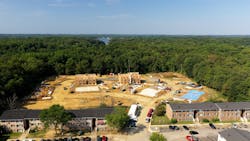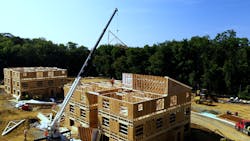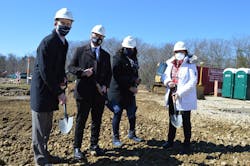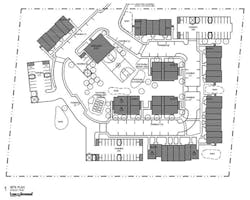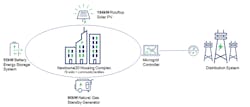Microgrid Feasibility: A Case Study from Annapolis
The frequency and intensity of naturally occurring threats is increasing. In Maryland alone, 41 billion-dollar-disaster events have totaled US$307 billion in damages over the last 20 years, a more than 50% increase from 1980 to 2000. Extreme weather events threaten the stability of the grid and cause power outages with significant economic losses.
Compounding these losses, communities with low-income and elderly populations are disproportionately affected by extreme weather events. For example, they often are less equipped to afford the cost of food waste caused by a refrigerator that has lost power and face a higher risk of fatality during extreme temperature events without a working heating, ventilation and air-conditioning system.
One such vulnerable community is the Newtowne Twenty affordable housing complex in Annapolis, Maryland. Newtowne Twenty is a 78-unit affordable housing development currently undergoing revitalization. Local stakeholders and the utility were interested in assessing the feasibility of adding a microgrid to the development, which would introduce locally generated solar energy and increased resilience. The Maryland Energy Administration (MEA) partially funded a microgrid feasibility study through its Resilient Maryland program, with the remaining donated funds and working time coming from the Smart Electric Power Alliance (SEPA), Baltimore Gas and Electric Co. (BGE) and Housing Authority of the City of Annapolis (HACA).
The project team followed a five-step process for the microgrid feasibility study: Convene industry and community stakeholders, assess the site and collect energy consumption data, develop preliminary design scenarios, conduct preliminary engineering design, and analyze the benefits and costs.
Convene Stakeholders
To ensure the microgrid design would serve the needs of the community, the project team identified government and community stakeholders to include in regular project discussions. Each month, team members provided information about the purpose of the microgrid, shared project updates and findings, and held an open dialogue for stakeholders to provide feedback. Stakeholders were given the opportunity to ask questions, participate in roundtable discussions and, ultimately, choose the microgrid design scenario they determined would best suit their community.
The purpose of stakeholder engagement was to provide participants with the information they needed to engage in a meaningful conversation on issues and communicate, via feedback, their input to effect change in the project design. Fostering a collaborative relationship with stakeholders encouraged productive conversations and provided the core team with key input regarding the microgrid study, site and design that would best serve the community’s needs.
Define Resilience
Resilience is a term that means different things to different stakeholders and is valued in different ways. Any initiative that seeks to build resilience first must ask the community members involved what resilience means to them. The stakeholders involved in this project shared how they envisioned a more resilient community. They identified backup power during critical weather events as an important aspect of resilience. They also indicated resilience is increased using clean energy, including renewables, solar and battery-storage grid assets that contribute to air quality.
Because natural gas infrastructure already exists at the Newtowne Twenty affordable housing community, stakeholders agreed a microgrid solution could use minimal natural gas to support backup generation. They also stressed that efforts to build resilience, like community center resilience hubs, should be economically strategic and provide affordable energy that results in bill savings for customers. In addition to being affordable, a resilient asset should be accessible, power the entire community and provide a community-wide sphere of influence.
Collect Data to Model Scenarios
The team collected data from a variety of sources to model preliminary microgrid scenarios. The projected load for the total site was estimated based on historical data of annual electricity usage of the residents and community center provided by BGE. The data also helped to quantify the load duration curves, which communicated how much designed load each microgrid scenario could serve.
To plan where to construct the microgrid on-site, developers and architects provided information regarding the space availability and equipment footprint for storage systems and standby generators, roof space and land availability for solar, and existing natural gas supply infrastructure. BGE also provided the team with state and local emissions and permitting requirements to determine the feasibility of natural gas generation.
The project team then collected schematics related to the capacity and locations of the natural gas lines on-site to appropriately size natural gas generation for the scenarios. The site limitations informed the fuel source mix and low, moderate and high renewable scenarios for the microgrid designs.
As a result of these meaningful conversations, the stakeholders and project team decided to move forward studying a microgrid design that would provide power to the entire site’s load, have a backup capability of at least five days, and incorporate both clean energy and natural gas to minimize costs. Therefore, the team chose to move forward with a more detailed feasibility study on scenario 2.
Develop the Benefit-Cost Analysis
When making investments in advanced energy projects, it often is important to evaluate the costs of the project compared to the expected benefits. Such assessments are especially important when the investment is being made for public benefit or when externalized or non-economized benefits — such as cleaner air, reduced greenhouse gas (GHG) emissions and improved public health — are realized.
Development of the benefit and cost inventory depends on detailed information about the proposed microgrid project. The Newtowne Twenty affordable housing community project provided substantial benefit from solar production, the associated environmental benefit and resilience. However, because of the small scale of this project and limited number of residential customers served, these benefits on their own would not balance the construction and operation and maintenance costs. The team determined the total net present value of benefits was US$397, 998 while the total net present value of costs was more than US$1.7 million. The total net impact of benefits would be significantly negative on a first-year basis as well as over the life of the project. This resulted in a total benefit-cost ratio of 0.24, below the 1.0 ratio threshold that would represent net benefit.
However, the low benefit-cost outcome was not the whole story. Small-scale pilot programs based on new technology frequently result in unfavorable benefit-cost ratios, especially when fixed costs are large. Trialing new technologies, strategies and programs offer learning opportunities and may advance strategic goals that hold intrinsic value but often are not quantifiable or included in a feasibility analysis. Externalities, such as the value of reducing emissions, likely are undervalued in these scenarios despite providing important societal benefits. Most importantly, the research and methodologies for quantifying the economic value of resilience is relatively new and likely incomplete. As such, they may not capture the strategic value of improved resilience, especially as more extreme weather (and other) events become more common.
Technically Feasible
With the study complete, from the perspective of technical feasibility, the Newtowne Twenty affordable housing community is a workable site to construct and install a microgrid project. Industry stakeholders, members of the community and residents all believe the project would increase equity in Maryland by serving a low-income community. Stakeholders also understand the project would provide backup power from a mix of energy sources to help contribute to the city and state’s environmental goals. Above all, stakeholders support this endeavor to provide resilience and increase safety to the community by enabling access to critical services during prolonged outages.
The study developed the groundwork to move to a more detailed benefit-cost analysis and, ultimately, to the implementation phase of the microgrid development. The potential next steps include a determination of ownership and operation structures, further construction coordination, identification of financing and funding, and the development of a full engineering design and construction study. The continuation of strong engagement with community stakeholders through the implementation of the microgrid will facilitate the success of this project.
Jared Leader joined SEPA in 2017. In his role as the senior manager, research and industry strategy, he develops strategic plans for programs, products, and service offerings for utility and industry stakeholder members and clients that facilitate the integration of distributed energy resources, non-wires alternatives and microgrids onto the modern grid. He leads SEPA’s microgrids working group and co-led the District of Columbia Public Service Commission’s grid modernization working groups. Prior to joining SEPA, Leader spent several years working as an environmental engineer and consultant for utility, municipal and commercial clients in the energy and water sectors. He has a master’s degree in energy policy and climate from Johns Hopkins University and a bachelor’s degree in civil and environmental engineering from the University of Virginia.
Justin Felt is manager of strategic planning at BGE. He supports the utility of the future team in the development and sustainment of programs that integrate distributed energy resources such as storage, solar and microgrid technologies. Felt joined BGE in 2018 with over 13 years of clean energy experience. He most recently advised the U.S. Department of Defense on the development of resilient and renewable on-site power systems as part of the Army’s Office of Energy Initiatives and Air Force’s Office of Energy Assurance. At Thomson Reuters, he acted as head of renewable market strategy and consulted with energy and financial companies regarding environmental markets.
Acknowledgments
The authors would like to acknowledge the following contributors:
Jennifer Adams serves as director of development at HACA. She leads the effort to redevelop and reposition 935 public housing apartment units in nine properties through a variety of U.S. Department of Housing and Urban Development (HUD) funding tools. These HUD programs include the Rental Assistance Demonstration (RAD) program, Section 18/Demolition-Disposition, and Choice Neighborhoods and are typically paired with low-income housing tax credits with the goal of producing modern, energy-efficient housing for aging public housing portfolios. Prior to her work with HACA, Adams spent seven years with the Housing Authority of New Orleans overseeing the development of eight public housing properties.
Patrick Stewart serves as the regional vice president of the Maryland region for Pennrose, a real estate development and professional property management services company. Stewart joined Pennrose in 2013 and has been active in all facets of the real estate development process, including financial analysis and feasibility, assembling and leading the development team, securing entitlements, and overseeing construction, lease-up and stabilized occupancy.
Key Takeaways and Next Steps
- Following are key takeaways from the Maryland Energy Administration’s microgrid feasibility study:
- The value of resilience is undervalued, and it is difficult to quantify the community benefit beyond the direct benefit to the residents.
- The solar benefits are undervalued in the current benefit-cost framework and dependent on whether the revenue stream uses the retail rate or avoided cost.
- The approach to the benefit-cost analysis and stakeholder engagement can be applied to other projects in the state.
- Given the disconnect between upfront costs and long-term payback, it is important to open up funding to projects like this.
With the study complete and the Newtowne Twenty housing complex found to be a technically feasible site for a microgrid, here are the next steps to be taken:
- Ownership and operation structures between BGE, Newtowne Twenty affordable housing community residents and a developer must be determined to have the appropriate information for the final benefit-cost analysis.
- Current and planned construction activities need to be coordinated between BGE and HACA.
- Potential funding sources need to be identified to facilitate a public-private partnership (for example, third-party finance, customer finance, utility investment and recovery in rates).
- A full engineering design and construction study needs to be conducted.
To learn more about additional SEPA microgrid research, go to sepapower.org.
About the Author
Jared Leader
Jared joined SEPA in 2017. In his role, he develops strategic plans for programs, products, and service offerings for utility and industry stakeholder members and clients that facilitate the integration of distributed energy resources, non-wires alternatives and microgrids onto the modern grid. Jared leads SEPA’s Microgrids Working Group and co-led D.C. Public Service Commission’s grid modernisation working groups. Prior to joining SEPA, he spent several years working as an environmental engineer and consultant for utility, municipal and commercial clients in the energy and water sectors. He has a MS, Energy Policy and Climate from Johns Hopkins University, and a BS in Civil and Environmental Engineering from the University of Virginia. Outside of business hours, Jared enjoys skiing, hiking and spending time in the great outdoors.
Justin Felt
Justin Felt is manager of strategic planning at BGE. He supports the utility of the future team in the development and sustainment of programs that integrate distributed energy resources such as storage, solar and microgrid technologies. Felt joined BGE in 2018 with over 13 years of clean energy experience. He most recently advised the U.S. Department of Defense on the development of resilient and renewable on-site power systems as part of the Army’s Office of Energy Initiatives and Air Force’s Office of Energy Assurance. At Thomson Reuters, he acted as head of renewable market strategy and consulted with energy and financial companies regarding environmental markets.
Jennifer Adams
Jennifer Adams serves as director of development at HACA. She leads the effort to redevelop and reposition 935 public housing apartment units in nine properties through a variety of U.S. Department of Housing and Urban Development (HUD) funding tools. These HUD programs include the Rental Assistance Demonstration (RAD) program, Section 18/Demolition-Disposition, and Choice Neighborhoods and are typically paired with low-income housing tax credits with the goal of producing modern, energy-efficient housing for aging public housing portfolios. Prior to her work with HACA, Adams spent seven years with the Housing Authority of New Orleans overseeing the development of eight public housing properties and seven years with the Georgia Department of Community Affairs drafting architectural policy and providing construction oversight for the low-income housing tax credit program. Adams has a bachelor’s degree in building construction from the Georgia Institute of Technology and a master’s degree in architectural history from the Savannah College of Art and Design.
Patrick Stewart
Patrick Stewart serves as the regional vice president of the Maryland region for Pennrose, a real estate development and professional property management services company. Stewart joined Pennrose in 2013 and has been active in all facets of the real estate development process, including financial analysis and feasibility, assembling and leading the development team, securing entitlements, and overseeing construction, lease-up and stabilized occupancy. Prior to Pennrose, Stewart served as a project manager in the New York City Mayor’s Office of Capital Project Development. He has a master’s degree in city and regional planning from the University of Pennsylvania, where he also earned a certificate in real estate design and development through a joint program of the Wharton school of business and the graduate school of design.
